Effects of WTO Laws and Policies on Environmental Protection: A Study
VerifiedAdded on 2020/10/04
|42
|17000
|53
Essay
AI Summary
This essay delves into the intricate relationship between the World Trade Organization (WTO) and environmental protection, examining the effects of contradictory laws and policies of WTO members on WTO principles. The paper explores the WTO's operational approach, dispute settlement procedures, and the principles of non-discrimination, including Most Favored Nation Treatment and National Treatment. It investigates the general exceptions provided to WTO members and assesses the applicability of Article XX of GATT 1994, analyzing significant cases like the Shrimp and Turtle case and the Tuna-Dolphin I-II case. The essay further discusses the complications of adaptation and interpretation of Article XX, proposing necessary amendments to the Article XX standard, and provides a comprehensive analysis of the interplay between international trade regulations and environmental concerns.
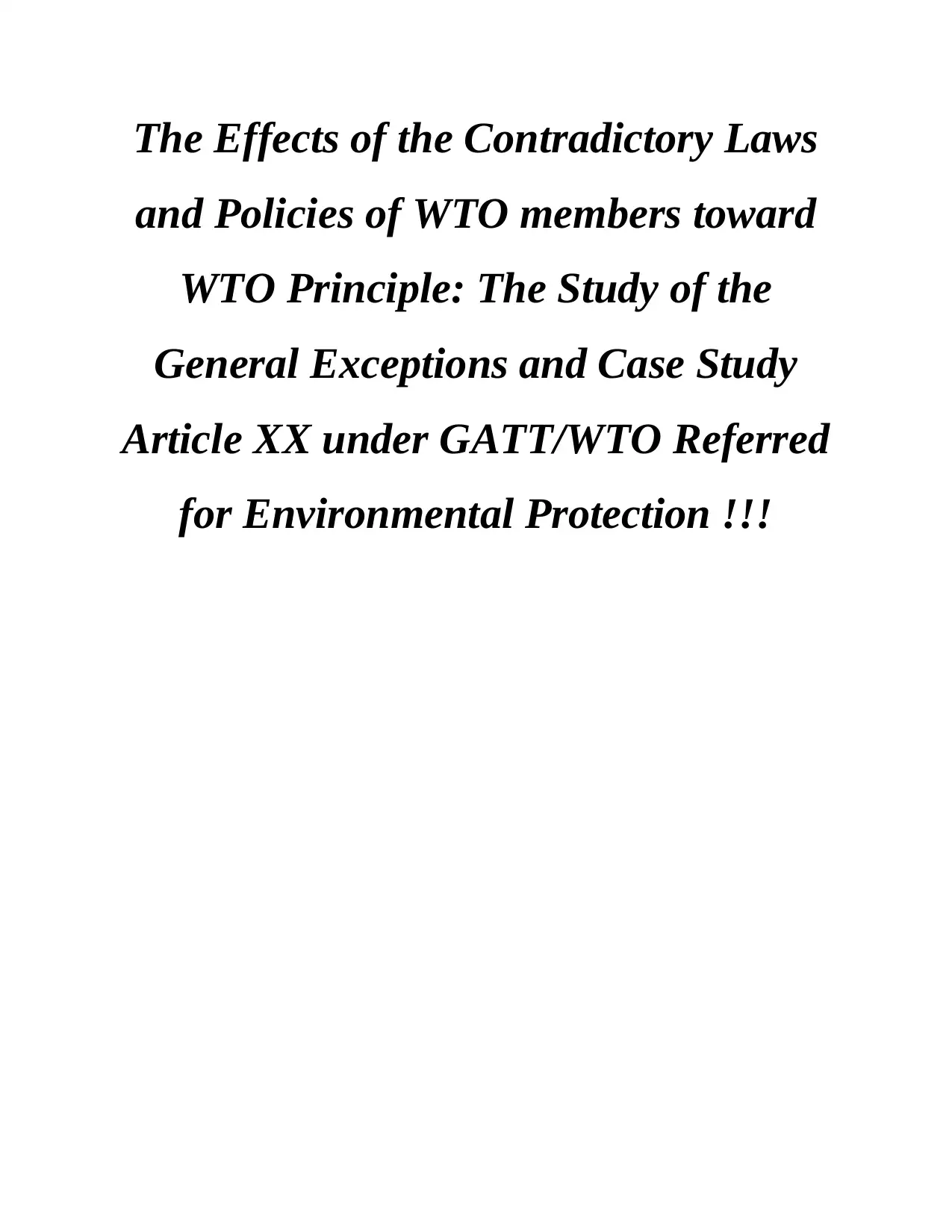
The Effects of the Contradictory Laws
and Policies of WTO members toward
WTO Principle: The Study of the
General Exceptions and Case Study
Article XX under GATT/WTO Referred
for Environmental Protection !!!
and Policies of WTO members toward
WTO Principle: The Study of the
General Exceptions and Case Study
Article XX under GATT/WTO Referred
for Environmental Protection !!!
Paraphrase This Document
Need a fresh take? Get an instant paraphrase of this document with our AI Paraphraser
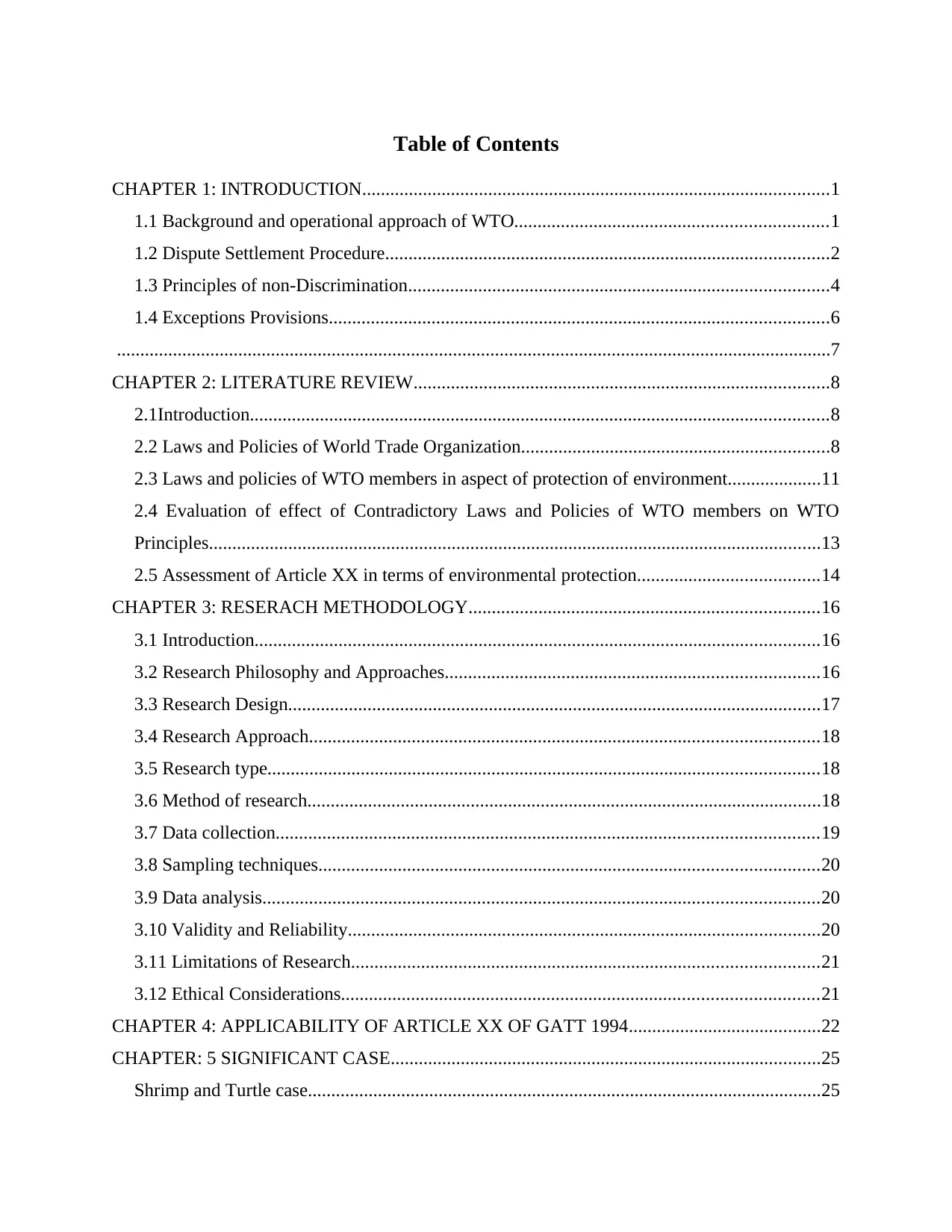
Table of Contents
CHAPTER 1: INTRODUCTION....................................................................................................1
1.1 Background and operational approach of WTO...................................................................1
1.2 Dispute Settlement Procedure...............................................................................................2
1.3 Principles of non-Discrimination..........................................................................................4
1.4 Exceptions Provisions...........................................................................................................6
.........................................................................................................................................................7
CHAPTER 2: LITERATURE REVIEW.........................................................................................8
2.1Introduction............................................................................................................................8
2.2 Laws and Policies of World Trade Organization..................................................................8
2.3 Laws and policies of WTO members in aspect of protection of environment....................11
2.4 Evaluation of effect of Contradictory Laws and Policies of WTO members on WTO
Principles...................................................................................................................................13
2.5 Assessment of Article XX in terms of environmental protection.......................................14
CHAPTER 3: RESERACH METHODOLOGY...........................................................................16
3.1 Introduction.........................................................................................................................16
3.2 Research Philosophy and Approaches................................................................................16
3.3 Research Design..................................................................................................................17
3.4 Research Approach.............................................................................................................18
3.5 Research type......................................................................................................................18
3.6 Method of research..............................................................................................................18
3.7 Data collection....................................................................................................................19
3.8 Sampling techniques...........................................................................................................20
3.9 Data analysis.......................................................................................................................20
3.10 Validity and Reliability.....................................................................................................20
3.11 Limitations of Research....................................................................................................21
3.12 Ethical Considerations......................................................................................................21
CHAPTER 4: APPLICABILITY OF ARTICLE XX OF GATT 1994.........................................22
CHAPTER: 5 SIGNIFICANT CASE............................................................................................25
Shrimp and Turtle case..............................................................................................................25
CHAPTER 1: INTRODUCTION....................................................................................................1
1.1 Background and operational approach of WTO...................................................................1
1.2 Dispute Settlement Procedure...............................................................................................2
1.3 Principles of non-Discrimination..........................................................................................4
1.4 Exceptions Provisions...........................................................................................................6
.........................................................................................................................................................7
CHAPTER 2: LITERATURE REVIEW.........................................................................................8
2.1Introduction............................................................................................................................8
2.2 Laws and Policies of World Trade Organization..................................................................8
2.3 Laws and policies of WTO members in aspect of protection of environment....................11
2.4 Evaluation of effect of Contradictory Laws and Policies of WTO members on WTO
Principles...................................................................................................................................13
2.5 Assessment of Article XX in terms of environmental protection.......................................14
CHAPTER 3: RESERACH METHODOLOGY...........................................................................16
3.1 Introduction.........................................................................................................................16
3.2 Research Philosophy and Approaches................................................................................16
3.3 Research Design..................................................................................................................17
3.4 Research Approach.............................................................................................................18
3.5 Research type......................................................................................................................18
3.6 Method of research..............................................................................................................18
3.7 Data collection....................................................................................................................19
3.8 Sampling techniques...........................................................................................................20
3.9 Data analysis.......................................................................................................................20
3.10 Validity and Reliability.....................................................................................................20
3.11 Limitations of Research....................................................................................................21
3.12 Ethical Considerations......................................................................................................21
CHAPTER 4: APPLICABILITY OF ARTICLE XX OF GATT 1994.........................................22
CHAPTER: 5 SIGNIFICANT CASE............................................................................................25
Shrimp and Turtle case..............................................................................................................25
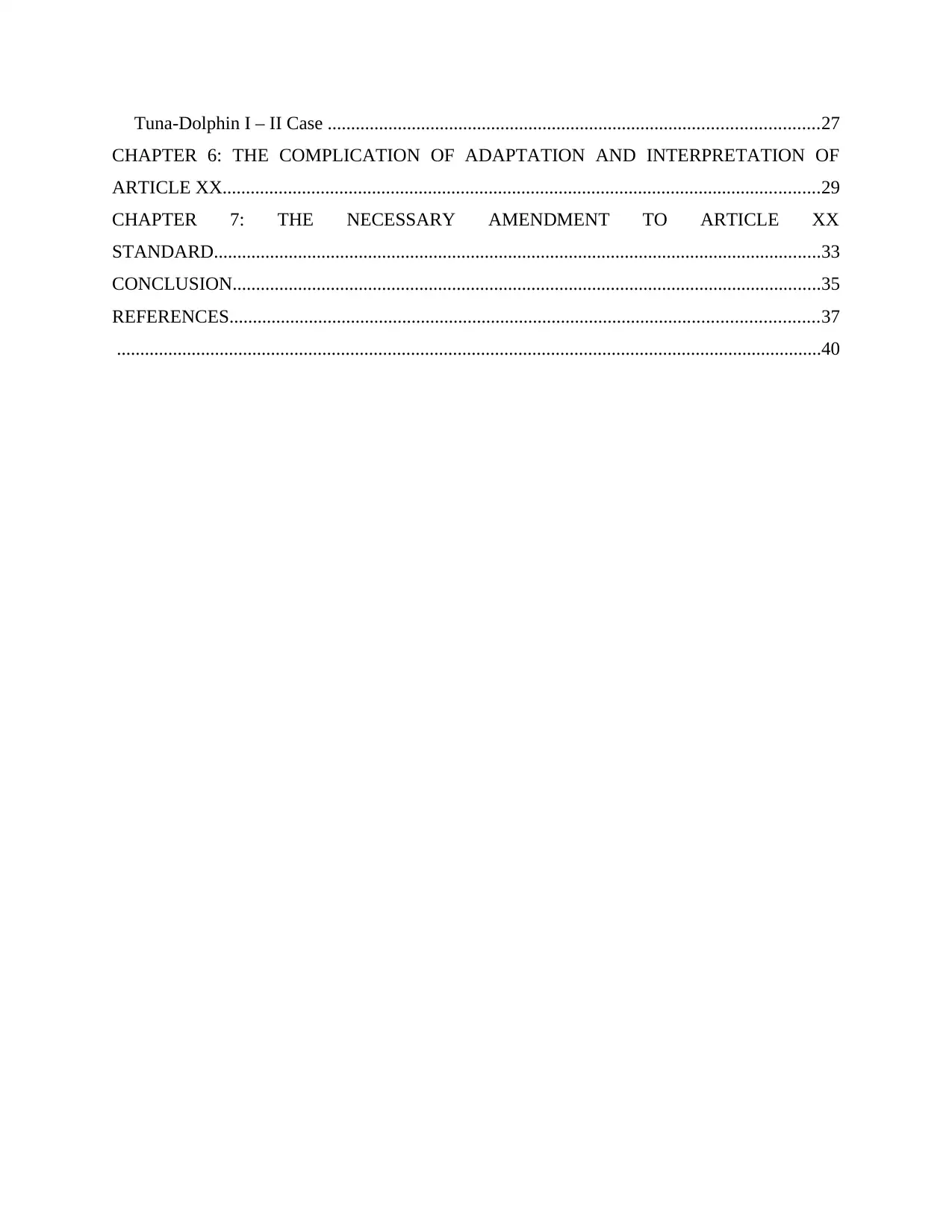
Tuna-Dolphin I – II Case .........................................................................................................27
CHAPTER 6: THE COMPLICATION OF ADAPTATION AND INTERPRETATION OF
ARTICLE XX................................................................................................................................29
CHAPTER 7: THE NECESSARY AMENDMENT TO ARTICLE XX
STANDARD..................................................................................................................................33
CONCLUSION..............................................................................................................................35
REFERENCES..............................................................................................................................37
.......................................................................................................................................................40
CHAPTER 6: THE COMPLICATION OF ADAPTATION AND INTERPRETATION OF
ARTICLE XX................................................................................................................................29
CHAPTER 7: THE NECESSARY AMENDMENT TO ARTICLE XX
STANDARD..................................................................................................................................33
CONCLUSION..............................................................................................................................35
REFERENCES..............................................................................................................................37
.......................................................................................................................................................40
⊘ This is a preview!⊘
Do you want full access?
Subscribe today to unlock all pages.

Trusted by 1+ million students worldwide
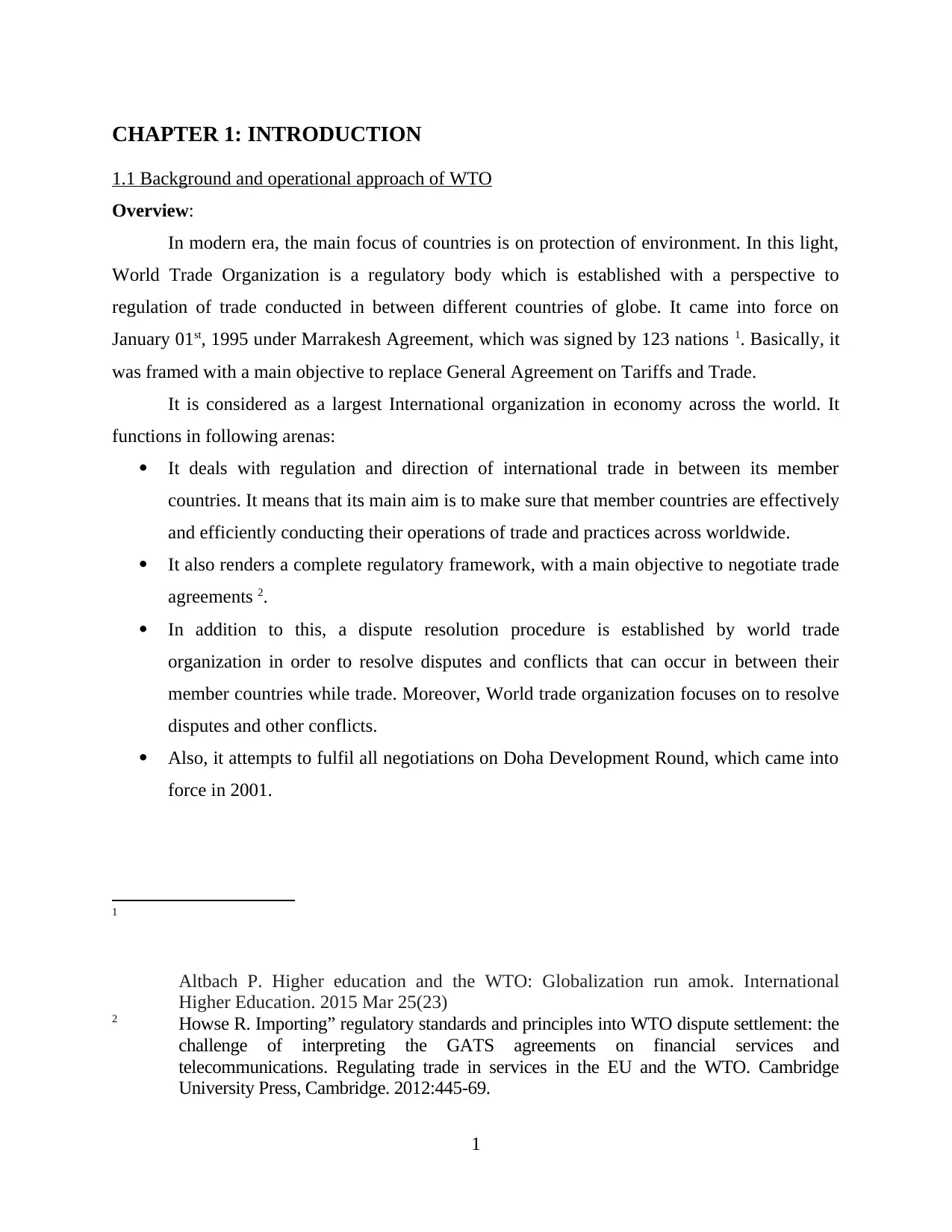
CHAPTER 1: INTRODUCTION
1.1 Background and operational approach of WTO
Overview:
In modern era, the main focus of countries is on protection of environment. In this light,
World Trade Organization is a regulatory body which is established with a perspective to
regulation of trade conducted in between different countries of globe. It came into force on
January 01st, 1995 under Marrakesh Agreement, which was signed by 123 nations 1. Basically, it
was framed with a main objective to replace General Agreement on Tariffs and Trade.
It is considered as a largest International organization in economy across the world. It
functions in following arenas:
It deals with regulation and direction of international trade in between its member
countries. It means that its main aim is to make sure that member countries are effectively
and efficiently conducting their operations of trade and practices across worldwide.
It also renders a complete regulatory framework, with a main objective to negotiate trade
agreements 2.
In addition to this, a dispute resolution procedure is established by world trade
organization in order to resolve disputes and conflicts that can occur in between their
member countries while trade. Moreover, World trade organization focuses on to resolve
disputes and other conflicts.
Also, it attempts to fulfil all negotiations on Doha Development Round, which came into
force in 2001.
1
Altbach P. Higher education and the WTO: Globalization run amok. International
Higher Education. 2015 Mar 25(23)
2 Howse R. Importing” regulatory standards and principles into WTO dispute settlement: the
challenge of interpreting the GATS agreements on financial services and
telecommunications. Regulating trade in services in the EU and the WTO. Cambridge
University Press, Cambridge. 2012:445-69.
1
1.1 Background and operational approach of WTO
Overview:
In modern era, the main focus of countries is on protection of environment. In this light,
World Trade Organization is a regulatory body which is established with a perspective to
regulation of trade conducted in between different countries of globe. It came into force on
January 01st, 1995 under Marrakesh Agreement, which was signed by 123 nations 1. Basically, it
was framed with a main objective to replace General Agreement on Tariffs and Trade.
It is considered as a largest International organization in economy across the world. It
functions in following arenas:
It deals with regulation and direction of international trade in between its member
countries. It means that its main aim is to make sure that member countries are effectively
and efficiently conducting their operations of trade and practices across worldwide.
It also renders a complete regulatory framework, with a main objective to negotiate trade
agreements 2.
In addition to this, a dispute resolution procedure is established by world trade
organization in order to resolve disputes and conflicts that can occur in between their
member countries while trade. Moreover, World trade organization focuses on to resolve
disputes and other conflicts.
Also, it attempts to fulfil all negotiations on Doha Development Round, which came into
force in 2001.
1
Altbach P. Higher education and the WTO: Globalization run amok. International
Higher Education. 2015 Mar 25(23)
2 Howse R. Importing” regulatory standards and principles into WTO dispute settlement: the
challenge of interpreting the GATS agreements on financial services and
telecommunications. Regulating trade in services in the EU and the WTO. Cambridge
University Press, Cambridge. 2012:445-69.
1
Paraphrase This Document
Need a fresh take? Get an instant paraphrase of this document with our AI Paraphraser
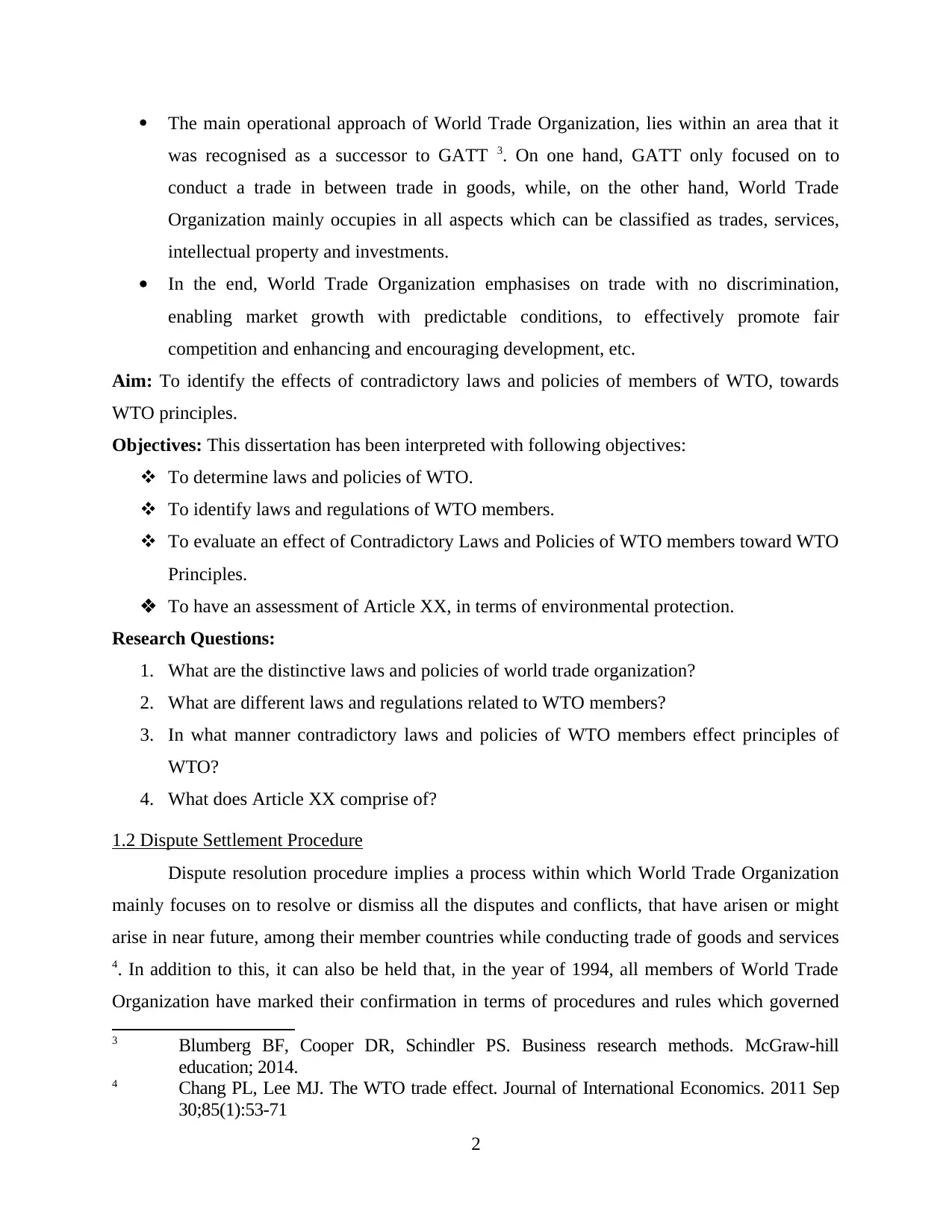
The main operational approach of World Trade Organization, lies within an area that it
was recognised as a successor to GATT 3. On one hand, GATT only focused on to
conduct a trade in between trade in goods, while, on the other hand, World Trade
Organization mainly occupies in all aspects which can be classified as trades, services,
intellectual property and investments.
In the end, World Trade Organization emphasises on trade with no discrimination,
enabling market growth with predictable conditions, to effectively promote fair
competition and enhancing and encouraging development, etc.
Aim: To identify the effects of contradictory laws and policies of members of WTO, towards
WTO principles.
Objectives: This dissertation has been interpreted with following objectives:
To determine laws and policies of WTO.
To identify laws and regulations of WTO members.
To evaluate an effect of Contradictory Laws and Policies of WTO members toward WTO
Principles.
To have an assessment of Article XX, in terms of environmental protection.
Research Questions:
1. What are the distinctive laws and policies of world trade organization?
2. What are different laws and regulations related to WTO members?
3. In what manner contradictory laws and policies of WTO members effect principles of
WTO?
4. What does Article XX comprise of?
1.2 Dispute Settlement Procedure
Dispute resolution procedure implies a process within which World Trade Organization
mainly focuses on to resolve or dismiss all the disputes and conflicts, that have arisen or might
arise in near future, among their member countries while conducting trade of goods and services
4. In addition to this, it can also be held that, in the year of 1994, all members of World Trade
Organization have marked their confirmation in terms of procedures and rules which governed
3 Blumberg BF, Cooper DR, Schindler PS. Business research methods. McGraw-hill
education; 2014.
4 Chang PL, Lee MJ. The WTO trade effect. Journal of International Economics. 2011 Sep
30;85(1):53-71
2
was recognised as a successor to GATT 3. On one hand, GATT only focused on to
conduct a trade in between trade in goods, while, on the other hand, World Trade
Organization mainly occupies in all aspects which can be classified as trades, services,
intellectual property and investments.
In the end, World Trade Organization emphasises on trade with no discrimination,
enabling market growth with predictable conditions, to effectively promote fair
competition and enhancing and encouraging development, etc.
Aim: To identify the effects of contradictory laws and policies of members of WTO, towards
WTO principles.
Objectives: This dissertation has been interpreted with following objectives:
To determine laws and policies of WTO.
To identify laws and regulations of WTO members.
To evaluate an effect of Contradictory Laws and Policies of WTO members toward WTO
Principles.
To have an assessment of Article XX, in terms of environmental protection.
Research Questions:
1. What are the distinctive laws and policies of world trade organization?
2. What are different laws and regulations related to WTO members?
3. In what manner contradictory laws and policies of WTO members effect principles of
WTO?
4. What does Article XX comprise of?
1.2 Dispute Settlement Procedure
Dispute resolution procedure implies a process within which World Trade Organization
mainly focuses on to resolve or dismiss all the disputes and conflicts, that have arisen or might
arise in near future, among their member countries while conducting trade of goods and services
4. In addition to this, it can also be held that, in the year of 1994, all members of World Trade
Organization have marked their confirmation in terms of procedures and rules which governed
3 Blumberg BF, Cooper DR, Schindler PS. Business research methods. McGraw-hill
education; 2014.
4 Chang PL, Lee MJ. The WTO trade effect. Journal of International Economics. 2011 Sep
30;85(1):53-71
2
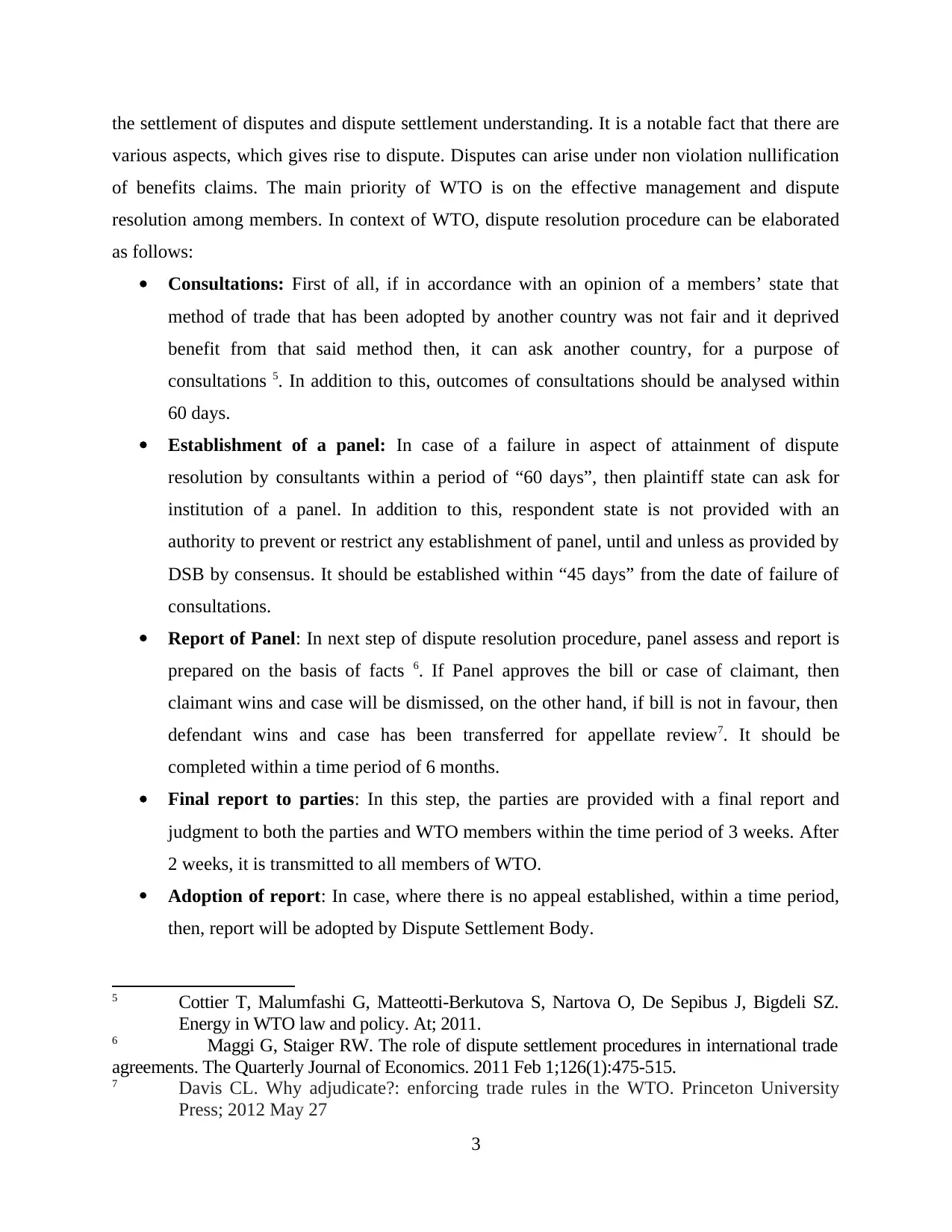
the settlement of disputes and dispute settlement understanding. It is a notable fact that there are
various aspects, which gives rise to dispute. Disputes can arise under non violation nullification
of benefits claims. The main priority of WTO is on the effective management and dispute
resolution among members. In context of WTO, dispute resolution procedure can be elaborated
as follows:
Consultations: First of all, if in accordance with an opinion of a members’ state that
method of trade that has been adopted by another country was not fair and it deprived
benefit from that said method then, it can ask another country, for a purpose of
consultations 5. In addition to this, outcomes of consultations should be analysed within
60 days.
Establishment of a panel: In case of a failure in aspect of attainment of dispute
resolution by consultants within a period of “60 days”, then plaintiff state can ask for
institution of a panel. In addition to this, respondent state is not provided with an
authority to prevent or restrict any establishment of panel, until and unless as provided by
DSB by consensus. It should be established within “45 days” from the date of failure of
consultations.
Report of Panel: In next step of dispute resolution procedure, panel assess and report is
prepared on the basis of facts 6. If Panel approves the bill or case of claimant, then
claimant wins and case will be dismissed, on the other hand, if bill is not in favour, then
defendant wins and case has been transferred for appellate review7. It should be
completed within a time period of 6 months.
Final report to parties: In this step, the parties are provided with a final report and
judgment to both the parties and WTO members within the time period of 3 weeks. After
2 weeks, it is transmitted to all members of WTO.
Adoption of report: In case, where there is no appeal established, within a time period,
then, report will be adopted by Dispute Settlement Body.
5 Cottier T, Malumfashi G, Matteotti-Berkutova S, Nartova O, De Sepibus J, Bigdeli SZ.
Energy in WTO law and policy. At; 2011.
6 Maggi G, Staiger RW. The role of dispute settlement procedures in international trade
agreements. The Quarterly Journal of Economics. 2011 Feb 1;126(1):475-515.
7 Davis CL. Why adjudicate?: enforcing trade rules in the WTO. Princeton University
Press; 2012 May 27
3
various aspects, which gives rise to dispute. Disputes can arise under non violation nullification
of benefits claims. The main priority of WTO is on the effective management and dispute
resolution among members. In context of WTO, dispute resolution procedure can be elaborated
as follows:
Consultations: First of all, if in accordance with an opinion of a members’ state that
method of trade that has been adopted by another country was not fair and it deprived
benefit from that said method then, it can ask another country, for a purpose of
consultations 5. In addition to this, outcomes of consultations should be analysed within
60 days.
Establishment of a panel: In case of a failure in aspect of attainment of dispute
resolution by consultants within a period of “60 days”, then plaintiff state can ask for
institution of a panel. In addition to this, respondent state is not provided with an
authority to prevent or restrict any establishment of panel, until and unless as provided by
DSB by consensus. It should be established within “45 days” from the date of failure of
consultations.
Report of Panel: In next step of dispute resolution procedure, panel assess and report is
prepared on the basis of facts 6. If Panel approves the bill or case of claimant, then
claimant wins and case will be dismissed, on the other hand, if bill is not in favour, then
defendant wins and case has been transferred for appellate review7. It should be
completed within a time period of 6 months.
Final report to parties: In this step, the parties are provided with a final report and
judgment to both the parties and WTO members within the time period of 3 weeks. After
2 weeks, it is transmitted to all members of WTO.
Adoption of report: In case, where there is no appeal established, within a time period,
then, report will be adopted by Dispute Settlement Body.
5 Cottier T, Malumfashi G, Matteotti-Berkutova S, Nartova O, De Sepibus J, Bigdeli SZ.
Energy in WTO law and policy. At; 2011.
6 Maggi G, Staiger RW. The role of dispute settlement procedures in international trade
agreements. The Quarterly Journal of Economics. 2011 Feb 1;126(1):475-515.
7 Davis CL. Why adjudicate?: enforcing trade rules in the WTO. Princeton University
Press; 2012 May 27
3
⊘ This is a preview!⊘
Do you want full access?
Subscribe today to unlock all pages.

Trusted by 1+ million students worldwide
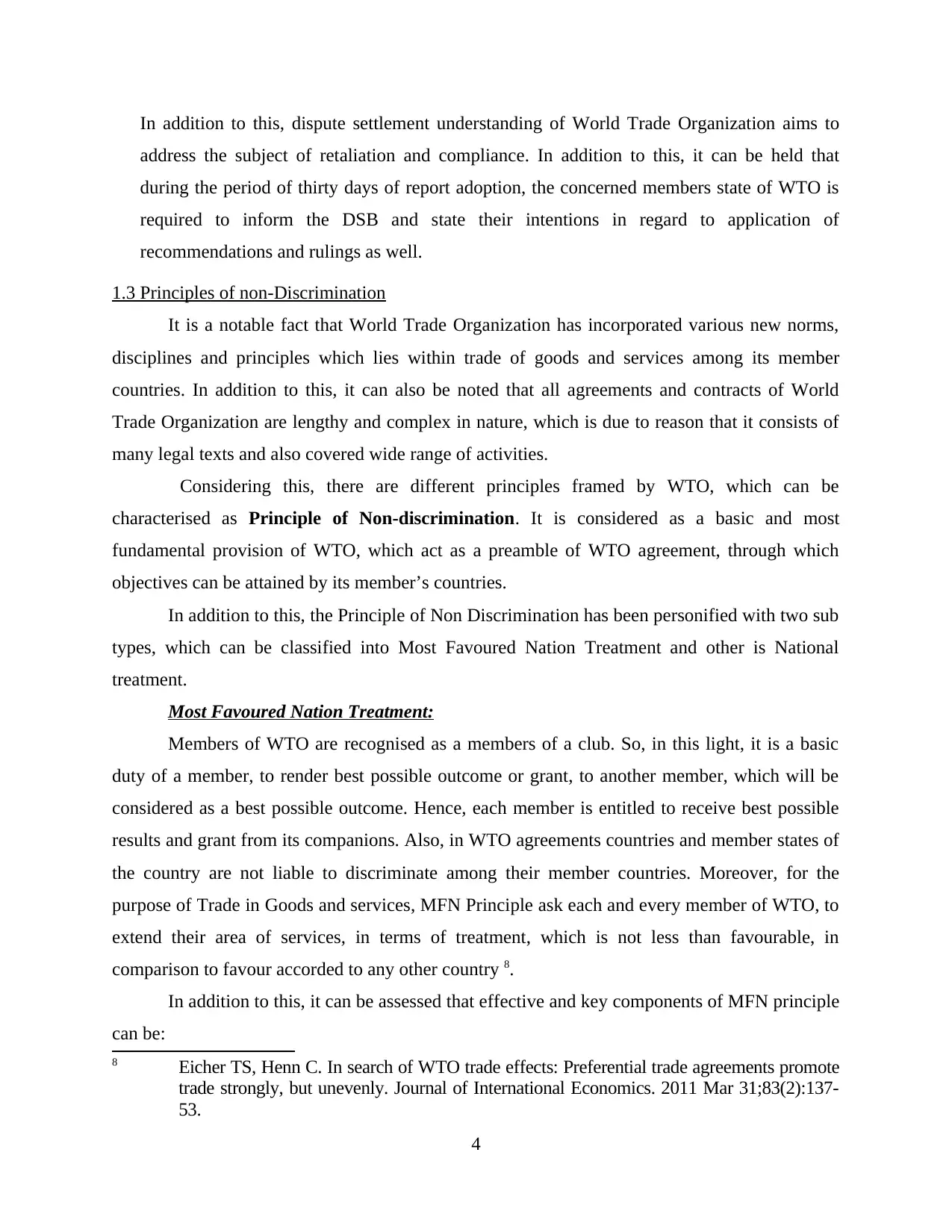
In addition to this, dispute settlement understanding of World Trade Organization aims to
address the subject of retaliation and compliance. In addition to this, it can be held that
during the period of thirty days of report adoption, the concerned members state of WTO is
required to inform the DSB and state their intentions in regard to application of
recommendations and rulings as well.
1.3 Principles of non-Discrimination
It is a notable fact that World Trade Organization has incorporated various new norms,
disciplines and principles which lies within trade of goods and services among its member
countries. In addition to this, it can also be noted that all agreements and contracts of World
Trade Organization are lengthy and complex in nature, which is due to reason that it consists of
many legal texts and also covered wide range of activities.
Considering this, there are different principles framed by WTO, which can be
characterised as Principle of Non-discrimination. It is considered as a basic and most
fundamental provision of WTO, which act as a preamble of WTO agreement, through which
objectives can be attained by its member’s countries.
In addition to this, the Principle of Non Discrimination has been personified with two sub
types, which can be classified into Most Favoured Nation Treatment and other is National
treatment.
Most Favoured Nation Treatment:
Members of WTO are recognised as a members of a club. So, in this light, it is a basic
duty of a member, to render best possible outcome or grant, to another member, which will be
considered as a best possible outcome. Hence, each member is entitled to receive best possible
results and grant from its companions. Also, in WTO agreements countries and member states of
the country are not liable to discriminate among their member countries. Moreover, for the
purpose of Trade in Goods and services, MFN Principle ask each and every member of WTO, to
extend their area of services, in terms of treatment, which is not less than favourable, in
comparison to favour accorded to any other country 8.
In addition to this, it can be assessed that effective and key components of MFN principle
can be:
8 Eicher TS, Henn C. In search of WTO trade effects: Preferential trade agreements promote
trade strongly, but unevenly. Journal of International Economics. 2011 Mar 31;83(2):137-
53.
4
address the subject of retaliation and compliance. In addition to this, it can be held that
during the period of thirty days of report adoption, the concerned members state of WTO is
required to inform the DSB and state their intentions in regard to application of
recommendations and rulings as well.
1.3 Principles of non-Discrimination
It is a notable fact that World Trade Organization has incorporated various new norms,
disciplines and principles which lies within trade of goods and services among its member
countries. In addition to this, it can also be noted that all agreements and contracts of World
Trade Organization are lengthy and complex in nature, which is due to reason that it consists of
many legal texts and also covered wide range of activities.
Considering this, there are different principles framed by WTO, which can be
characterised as Principle of Non-discrimination. It is considered as a basic and most
fundamental provision of WTO, which act as a preamble of WTO agreement, through which
objectives can be attained by its member’s countries.
In addition to this, the Principle of Non Discrimination has been personified with two sub
types, which can be classified into Most Favoured Nation Treatment and other is National
treatment.
Most Favoured Nation Treatment:
Members of WTO are recognised as a members of a club. So, in this light, it is a basic
duty of a member, to render best possible outcome or grant, to another member, which will be
considered as a best possible outcome. Hence, each member is entitled to receive best possible
results and grant from its companions. Also, in WTO agreements countries and member states of
the country are not liable to discriminate among their member countries. Moreover, for the
purpose of Trade in Goods and services, MFN Principle ask each and every member of WTO, to
extend their area of services, in terms of treatment, which is not less than favourable, in
comparison to favour accorded to any other country 8.
In addition to this, it can be assessed that effective and key components of MFN principle
can be:
8 Eicher TS, Henn C. In search of WTO trade effects: Preferential trade agreements promote
trade strongly, but unevenly. Journal of International Economics. 2011 Mar 31;83(2):137-
53.
4
Paraphrase This Document
Need a fresh take? Get an instant paraphrase of this document with our AI Paraphraser
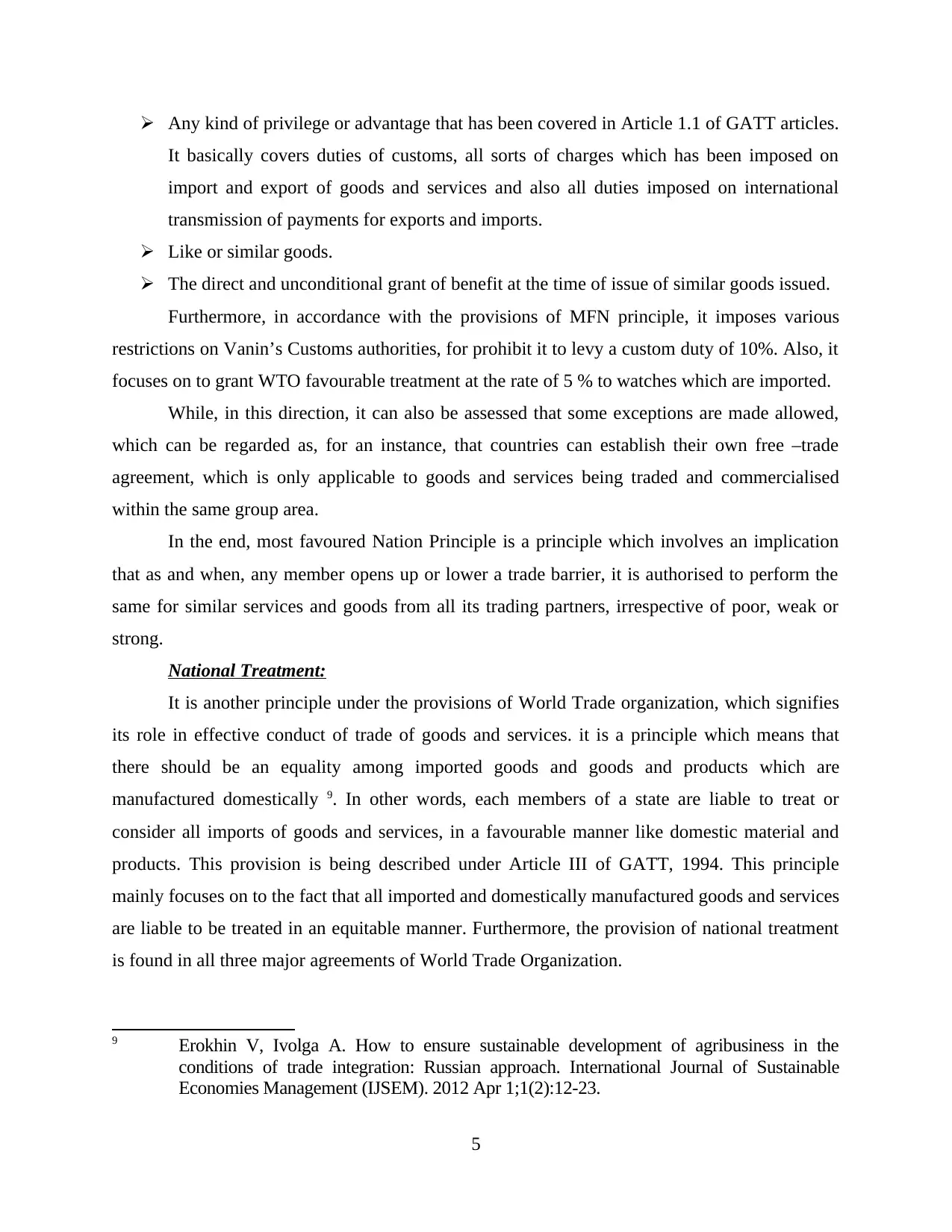
Any kind of privilege or advantage that has been covered in Article 1.1 of GATT articles.
It basically covers duties of customs, all sorts of charges which has been imposed on
import and export of goods and services and also all duties imposed on international
transmission of payments for exports and imports.
Like or similar goods.
The direct and unconditional grant of benefit at the time of issue of similar goods issued.
Furthermore, in accordance with the provisions of MFN principle, it imposes various
restrictions on Vanin’s Customs authorities, for prohibit it to levy a custom duty of 10%. Also, it
focuses on to grant WTO favourable treatment at the rate of 5 % to watches which are imported.
While, in this direction, it can also be assessed that some exceptions are made allowed,
which can be regarded as, for an instance, that countries can establish their own free –trade
agreement, which is only applicable to goods and services being traded and commercialised
within the same group area.
In the end, most favoured Nation Principle is a principle which involves an implication
that as and when, any member opens up or lower a trade barrier, it is authorised to perform the
same for similar services and goods from all its trading partners, irrespective of poor, weak or
strong.
National Treatment:
It is another principle under the provisions of World Trade organization, which signifies
its role in effective conduct of trade of goods and services. it is a principle which means that
there should be an equality among imported goods and goods and products which are
manufactured domestically 9. In other words, each members of a state are liable to treat or
consider all imports of goods and services, in a favourable manner like domestic material and
products. This provision is being described under Article III of GATT, 1994. This principle
mainly focuses on to the fact that all imported and domestically manufactured goods and services
are liable to be treated in an equitable manner. Furthermore, the provision of national treatment
is found in all three major agreements of World Trade Organization.
9 Erokhin V, Ivolga A. How to ensure sustainable development of agribusiness in the
conditions of trade integration: Russian approach. International Journal of Sustainable
Economies Management (IJSEM). 2012 Apr 1;1(2):12-23.
5
It basically covers duties of customs, all sorts of charges which has been imposed on
import and export of goods and services and also all duties imposed on international
transmission of payments for exports and imports.
Like or similar goods.
The direct and unconditional grant of benefit at the time of issue of similar goods issued.
Furthermore, in accordance with the provisions of MFN principle, it imposes various
restrictions on Vanin’s Customs authorities, for prohibit it to levy a custom duty of 10%. Also, it
focuses on to grant WTO favourable treatment at the rate of 5 % to watches which are imported.
While, in this direction, it can also be assessed that some exceptions are made allowed,
which can be regarded as, for an instance, that countries can establish their own free –trade
agreement, which is only applicable to goods and services being traded and commercialised
within the same group area.
In the end, most favoured Nation Principle is a principle which involves an implication
that as and when, any member opens up or lower a trade barrier, it is authorised to perform the
same for similar services and goods from all its trading partners, irrespective of poor, weak or
strong.
National Treatment:
It is another principle under the provisions of World Trade organization, which signifies
its role in effective conduct of trade of goods and services. it is a principle which means that
there should be an equality among imported goods and goods and products which are
manufactured domestically 9. In other words, each members of a state are liable to treat or
consider all imports of goods and services, in a favourable manner like domestic material and
products. This provision is being described under Article III of GATT, 1994. This principle
mainly focuses on to the fact that all imported and domestically manufactured goods and services
are liable to be treated in an equitable manner. Furthermore, the provision of national treatment
is found in all three major agreements of World Trade Organization.
9 Erokhin V, Ivolga A. How to ensure sustainable development of agribusiness in the
conditions of trade integration: Russian approach. International Journal of Sustainable
Economies Management (IJSEM). 2012 Apr 1;1(2):12-23.
5
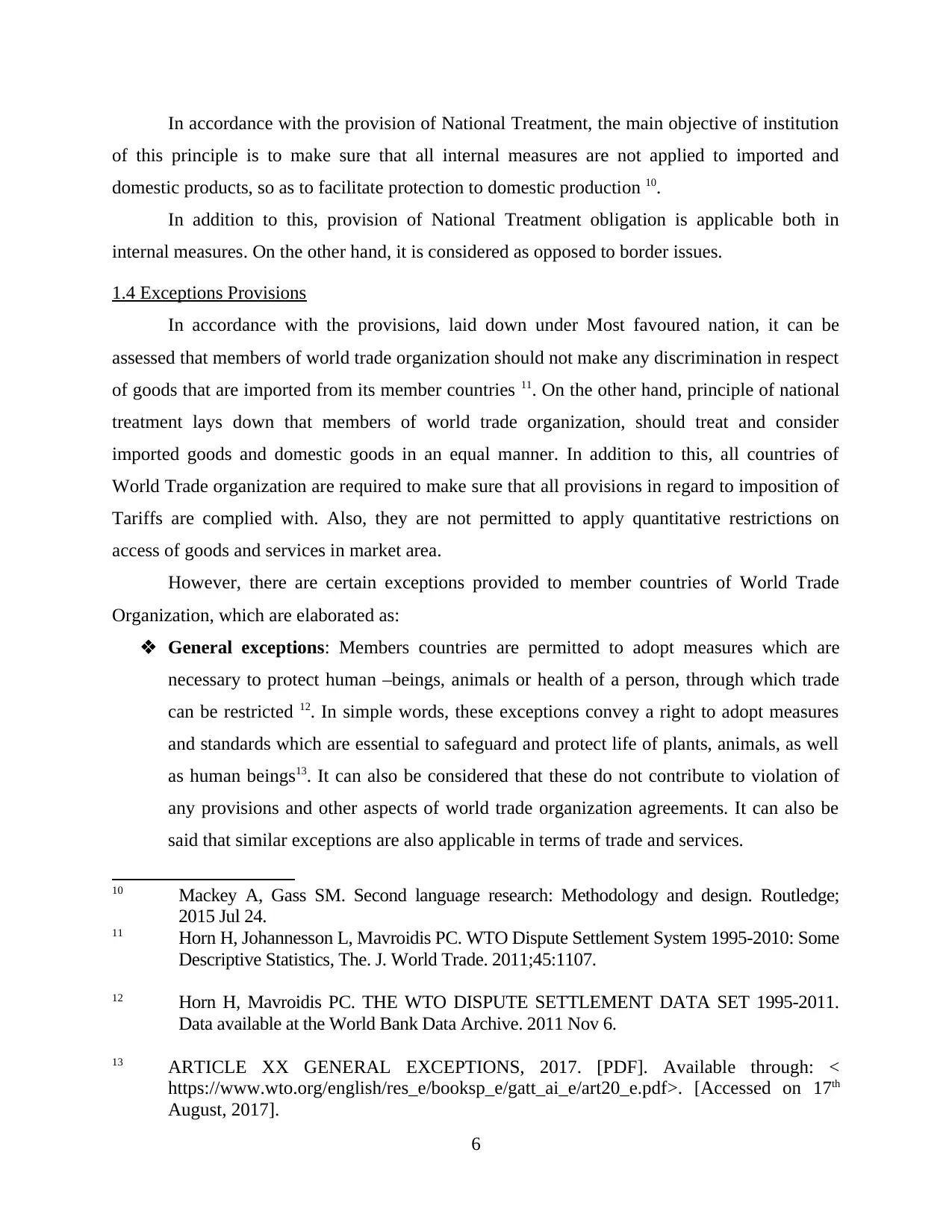
In accordance with the provision of National Treatment, the main objective of institution
of this principle is to make sure that all internal measures are not applied to imported and
domestic products, so as to facilitate protection to domestic production 10.
In addition to this, provision of National Treatment obligation is applicable both in
internal measures. On the other hand, it is considered as opposed to border issues.
1.4 Exceptions Provisions
In accordance with the provisions, laid down under Most favoured nation, it can be
assessed that members of world trade organization should not make any discrimination in respect
of goods that are imported from its member countries 11. On the other hand, principle of national
treatment lays down that members of world trade organization, should treat and consider
imported goods and domestic goods in an equal manner. In addition to this, all countries of
World Trade organization are required to make sure that all provisions in regard to imposition of
Tariffs are complied with. Also, they are not permitted to apply quantitative restrictions on
access of goods and services in market area.
However, there are certain exceptions provided to member countries of World Trade
Organization, which are elaborated as:
General exceptions: Members countries are permitted to adopt measures which are
necessary to protect human –beings, animals or health of a person, through which trade
can be restricted 12. In simple words, these exceptions convey a right to adopt measures
and standards which are essential to safeguard and protect life of plants, animals, as well
as human beings13. It can also be considered that these do not contribute to violation of
any provisions and other aspects of world trade organization agreements. It can also be
said that similar exceptions are also applicable in terms of trade and services.
10 Mackey A, Gass SM. Second language research: Methodology and design. Routledge;
2015 Jul 24.
11 Horn H, Johannesson L, Mavroidis PC. WTO Dispute Settlement System 1995-2010: Some
Descriptive Statistics, The. J. World Trade. 2011;45:1107.
12 Horn H, Mavroidis PC. THE WTO DISPUTE SETTLEMENT DATA SET 1995-2011.
Data available at the World Bank Data Archive. 2011 Nov 6.
13 ARTICLE XX GENERAL EXCEPTIONS, 2017. [PDF]. Available through: <
https://www.wto.org/english/res_e/booksp_e/gatt_ai_e/art20_e.pdf>. [Accessed on 17th
August, 2017].
6
of this principle is to make sure that all internal measures are not applied to imported and
domestic products, so as to facilitate protection to domestic production 10.
In addition to this, provision of National Treatment obligation is applicable both in
internal measures. On the other hand, it is considered as opposed to border issues.
1.4 Exceptions Provisions
In accordance with the provisions, laid down under Most favoured nation, it can be
assessed that members of world trade organization should not make any discrimination in respect
of goods that are imported from its member countries 11. On the other hand, principle of national
treatment lays down that members of world trade organization, should treat and consider
imported goods and domestic goods in an equal manner. In addition to this, all countries of
World Trade organization are required to make sure that all provisions in regard to imposition of
Tariffs are complied with. Also, they are not permitted to apply quantitative restrictions on
access of goods and services in market area.
However, there are certain exceptions provided to member countries of World Trade
Organization, which are elaborated as:
General exceptions: Members countries are permitted to adopt measures which are
necessary to protect human –beings, animals or health of a person, through which trade
can be restricted 12. In simple words, these exceptions convey a right to adopt measures
and standards which are essential to safeguard and protect life of plants, animals, as well
as human beings13. It can also be considered that these do not contribute to violation of
any provisions and other aspects of world trade organization agreements. It can also be
said that similar exceptions are also applicable in terms of trade and services.
10 Mackey A, Gass SM. Second language research: Methodology and design. Routledge;
2015 Jul 24.
11 Horn H, Johannesson L, Mavroidis PC. WTO Dispute Settlement System 1995-2010: Some
Descriptive Statistics, The. J. World Trade. 2011;45:1107.
12 Horn H, Mavroidis PC. THE WTO DISPUTE SETTLEMENT DATA SET 1995-2011.
Data available at the World Bank Data Archive. 2011 Nov 6.
13 ARTICLE XX GENERAL EXCEPTIONS, 2017. [PDF]. Available through: <
https://www.wto.org/english/res_e/booksp_e/gatt_ai_e/art20_e.pdf>. [Accessed on 17th
August, 2017].
6
⊘ This is a preview!⊘
Do you want full access?
Subscribe today to unlock all pages.

Trusted by 1+ million students worldwide
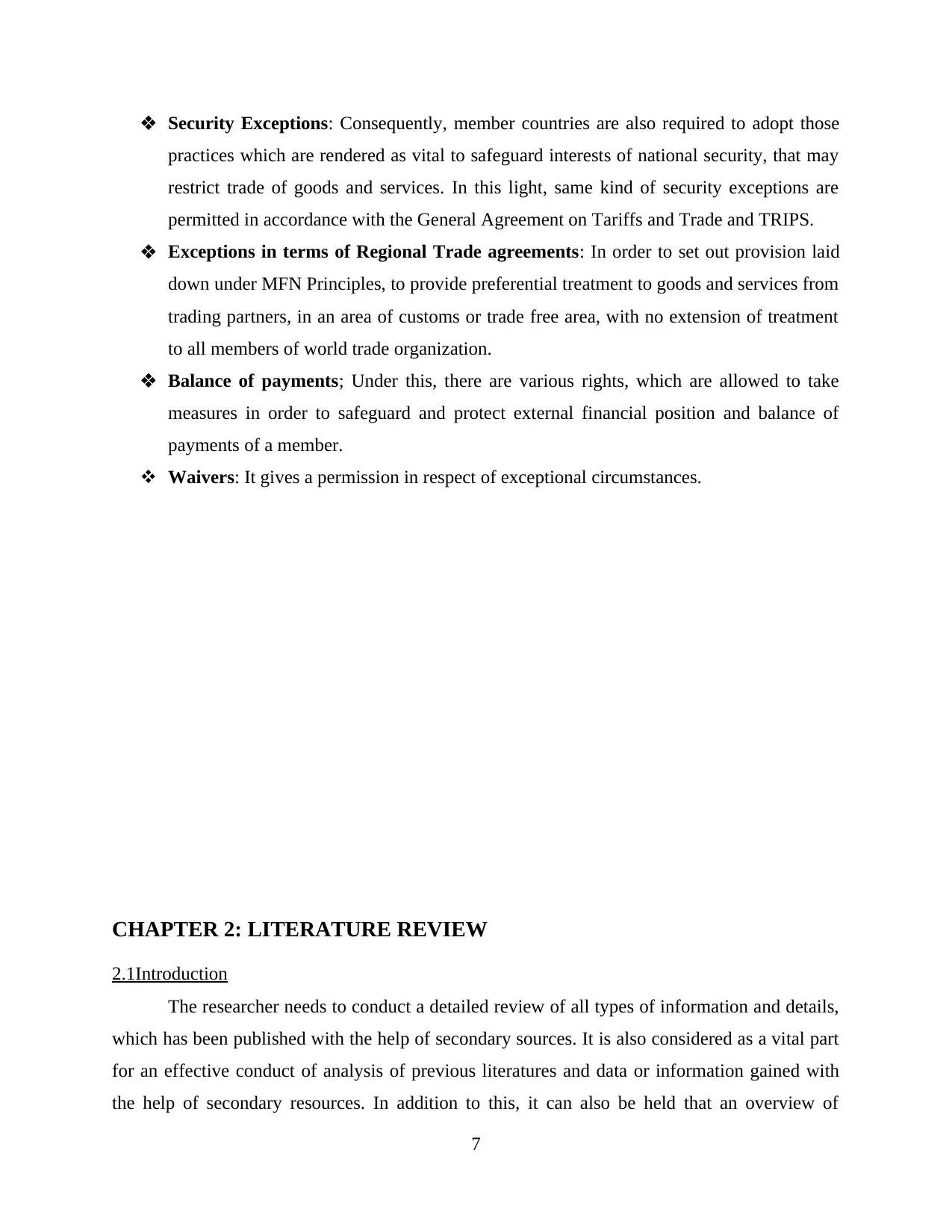
Security Exceptions: Consequently, member countries are also required to adopt those
practices which are rendered as vital to safeguard interests of national security, that may
restrict trade of goods and services. In this light, same kind of security exceptions are
permitted in accordance with the General Agreement on Tariffs and Trade and TRIPS.
Exceptions in terms of Regional Trade agreements: In order to set out provision laid
down under MFN Principles, to provide preferential treatment to goods and services from
trading partners, in an area of customs or trade free area, with no extension of treatment
to all members of world trade organization.
Balance of payments; Under this, there are various rights, which are allowed to take
measures in order to safeguard and protect external financial position and balance of
payments of a member.
Waivers: It gives a permission in respect of exceptional circumstances.
CHAPTER 2: LITERATURE REVIEW
2.1Introduction
The researcher needs to conduct a detailed review of all types of information and details,
which has been published with the help of secondary sources. It is also considered as a vital part
for an effective conduct of analysis of previous literatures and data or information gained with
the help of secondary resources. In addition to this, it can also be held that an overview of
7
practices which are rendered as vital to safeguard interests of national security, that may
restrict trade of goods and services. In this light, same kind of security exceptions are
permitted in accordance with the General Agreement on Tariffs and Trade and TRIPS.
Exceptions in terms of Regional Trade agreements: In order to set out provision laid
down under MFN Principles, to provide preferential treatment to goods and services from
trading partners, in an area of customs or trade free area, with no extension of treatment
to all members of world trade organization.
Balance of payments; Under this, there are various rights, which are allowed to take
measures in order to safeguard and protect external financial position and balance of
payments of a member.
Waivers: It gives a permission in respect of exceptional circumstances.
CHAPTER 2: LITERATURE REVIEW
2.1Introduction
The researcher needs to conduct a detailed review of all types of information and details,
which has been published with the help of secondary sources. It is also considered as a vital part
for an effective conduct of analysis of previous literatures and data or information gained with
the help of secondary resources. In addition to this, it can also be held that an overview of
7
Paraphrase This Document
Need a fresh take? Get an instant paraphrase of this document with our AI Paraphraser
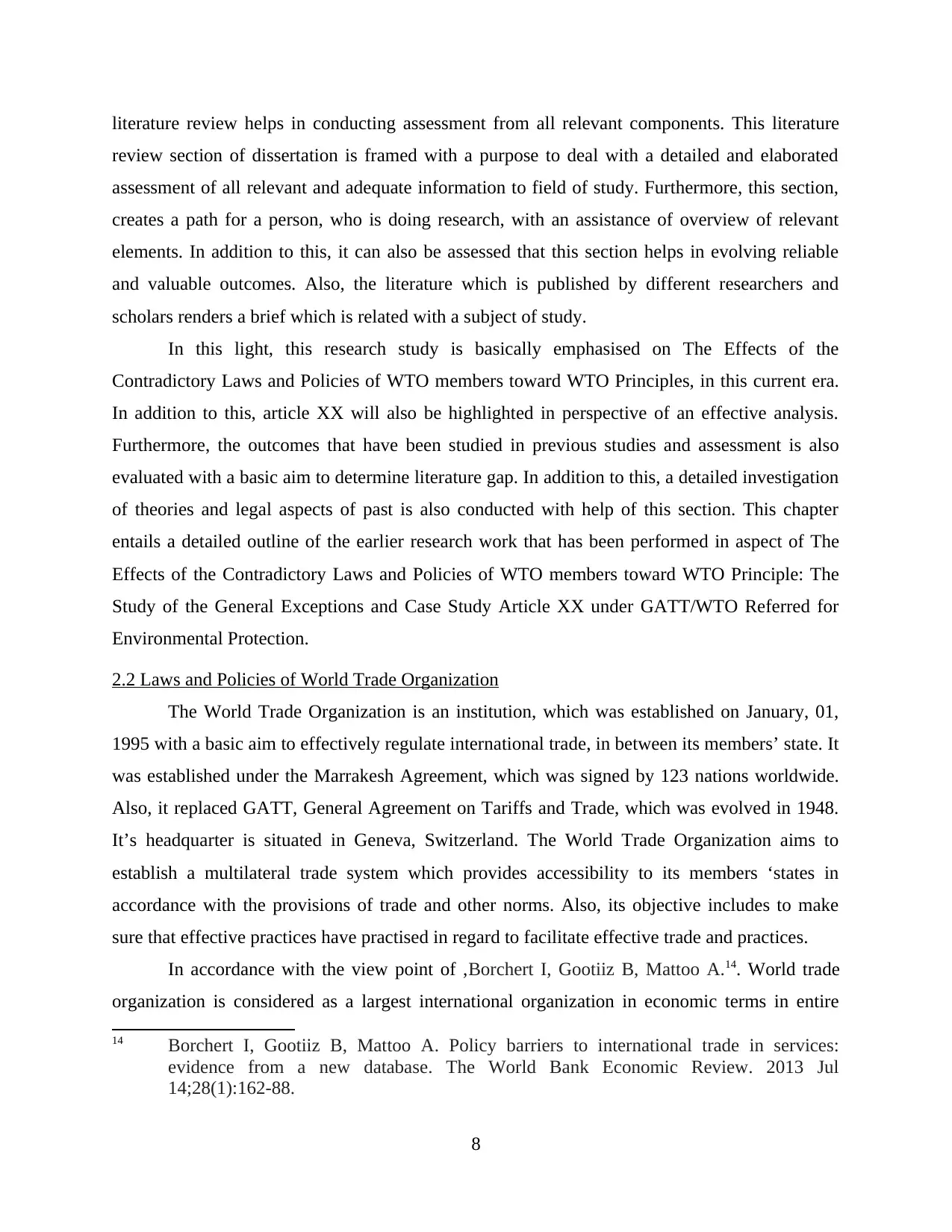
literature review helps in conducting assessment from all relevant components. This literature
review section of dissertation is framed with a purpose to deal with a detailed and elaborated
assessment of all relevant and adequate information to field of study. Furthermore, this section,
creates a path for a person, who is doing research, with an assistance of overview of relevant
elements. In addition to this, it can also be assessed that this section helps in evolving reliable
and valuable outcomes. Also, the literature which is published by different researchers and
scholars renders a brief which is related with a subject of study.
In this light, this research study is basically emphasised on The Effects of the
Contradictory Laws and Policies of WTO members toward WTO Principles, in this current era.
In addition to this, article XX will also be highlighted in perspective of an effective analysis.
Furthermore, the outcomes that have been studied in previous studies and assessment is also
evaluated with a basic aim to determine literature gap. In addition to this, a detailed investigation
of theories and legal aspects of past is also conducted with help of this section. This chapter
entails a detailed outline of the earlier research work that has been performed in aspect of The
Effects of the Contradictory Laws and Policies of WTO members toward WTO Principle: The
Study of the General Exceptions and Case Study Article XX under GATT/WTO Referred for
Environmental Protection.
2.2 Laws and Policies of World Trade Organization
The World Trade Organization is an institution, which was established on January, 01,
1995 with a basic aim to effectively regulate international trade, in between its members’ state. It
was established under the Marrakesh Agreement, which was signed by 123 nations worldwide.
Also, it replaced GATT, General Agreement on Tariffs and Trade, which was evolved in 1948.
It’s headquarter is situated in Geneva, Switzerland. The World Trade Organization aims to
establish a multilateral trade system which provides accessibility to its members ‘states in
accordance with the provisions of trade and other norms. Also, its objective includes to make
sure that effective practices have practised in regard to facilitate effective trade and practices.
In accordance with the view point of ,Borchert I, Gootiiz B, Mattoo A.14. World trade
organization is considered as a largest international organization in economic terms in entire
14 Borchert I, Gootiiz B, Mattoo A. Policy barriers to international trade in services:
evidence from a new database. The World Bank Economic Review. 2013 Jul
14;28(1):162-88.
8
review section of dissertation is framed with a purpose to deal with a detailed and elaborated
assessment of all relevant and adequate information to field of study. Furthermore, this section,
creates a path for a person, who is doing research, with an assistance of overview of relevant
elements. In addition to this, it can also be assessed that this section helps in evolving reliable
and valuable outcomes. Also, the literature which is published by different researchers and
scholars renders a brief which is related with a subject of study.
In this light, this research study is basically emphasised on The Effects of the
Contradictory Laws and Policies of WTO members toward WTO Principles, in this current era.
In addition to this, article XX will also be highlighted in perspective of an effective analysis.
Furthermore, the outcomes that have been studied in previous studies and assessment is also
evaluated with a basic aim to determine literature gap. In addition to this, a detailed investigation
of theories and legal aspects of past is also conducted with help of this section. This chapter
entails a detailed outline of the earlier research work that has been performed in aspect of The
Effects of the Contradictory Laws and Policies of WTO members toward WTO Principle: The
Study of the General Exceptions and Case Study Article XX under GATT/WTO Referred for
Environmental Protection.
2.2 Laws and Policies of World Trade Organization
The World Trade Organization is an institution, which was established on January, 01,
1995 with a basic aim to effectively regulate international trade, in between its members’ state. It
was established under the Marrakesh Agreement, which was signed by 123 nations worldwide.
Also, it replaced GATT, General Agreement on Tariffs and Trade, which was evolved in 1948.
It’s headquarter is situated in Geneva, Switzerland. The World Trade Organization aims to
establish a multilateral trade system which provides accessibility to its members ‘states in
accordance with the provisions of trade and other norms. Also, its objective includes to make
sure that effective practices have practised in regard to facilitate effective trade and practices.
In accordance with the view point of ,Borchert I, Gootiiz B, Mattoo A.14. World trade
organization is considered as a largest international organization in economic terms in entire
14 Borchert I, Gootiiz B, Mattoo A. Policy barriers to international trade in services:
evidence from a new database. The World Bank Economic Review. 2013 Jul
14;28(1):162-88.
8
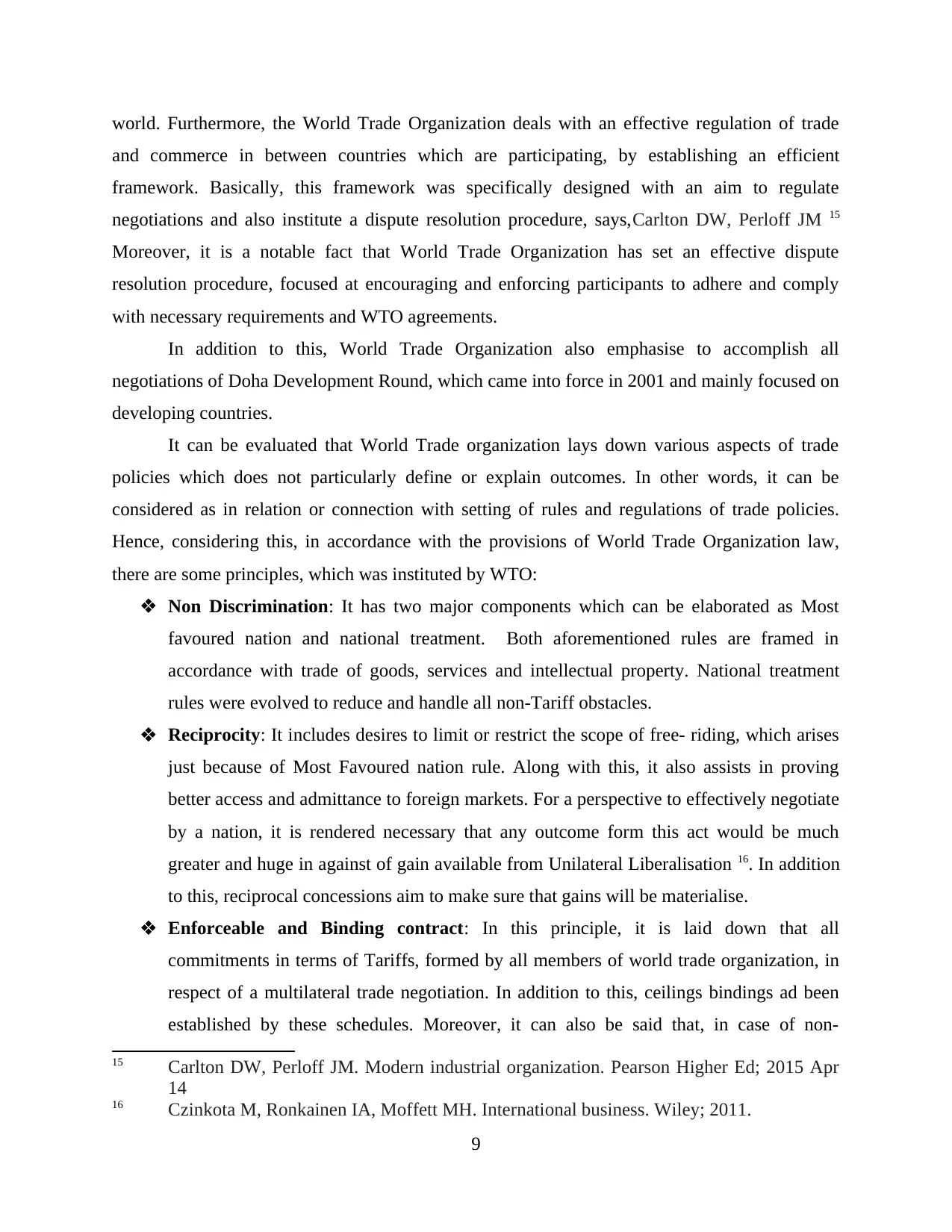
world. Furthermore, the World Trade Organization deals with an effective regulation of trade
and commerce in between countries which are participating, by establishing an efficient
framework. Basically, this framework was specifically designed with an aim to regulate
negotiations and also institute a dispute resolution procedure, says,Carlton DW, Perloff JM 15
Moreover, it is a notable fact that World Trade Organization has set an effective dispute
resolution procedure, focused at encouraging and enforcing participants to adhere and comply
with necessary requirements and WTO agreements.
In addition to this, World Trade Organization also emphasise to accomplish all
negotiations of Doha Development Round, which came into force in 2001 and mainly focused on
developing countries.
It can be evaluated that World Trade organization lays down various aspects of trade
policies which does not particularly define or explain outcomes. In other words, it can be
considered as in relation or connection with setting of rules and regulations of trade policies.
Hence, considering this, in accordance with the provisions of World Trade Organization law,
there are some principles, which was instituted by WTO:
Non Discrimination: It has two major components which can be elaborated as Most
favoured nation and national treatment. Both aforementioned rules are framed in
accordance with trade of goods, services and intellectual property. National treatment
rules were evolved to reduce and handle all non-Tariff obstacles.
Reciprocity: It includes desires to limit or restrict the scope of free- riding, which arises
just because of Most Favoured nation rule. Along with this, it also assists in proving
better access and admittance to foreign markets. For a perspective to effectively negotiate
by a nation, it is rendered necessary that any outcome form this act would be much
greater and huge in against of gain available from Unilateral Liberalisation 16. In addition
to this, reciprocal concessions aim to make sure that gains will be materialise.
Enforceable and Binding contract: In this principle, it is laid down that all
commitments in terms of Tariffs, formed by all members of world trade organization, in
respect of a multilateral trade negotiation. In addition to this, ceilings bindings ad been
established by these schedules. Moreover, it can also be said that, in case of non-
15 Carlton DW, Perloff JM. Modern industrial organization. Pearson Higher Ed; 2015 Apr
14
16 Czinkota M, Ronkainen IA, Moffett MH. International business. Wiley; 2011.
9
and commerce in between countries which are participating, by establishing an efficient
framework. Basically, this framework was specifically designed with an aim to regulate
negotiations and also institute a dispute resolution procedure, says,Carlton DW, Perloff JM 15
Moreover, it is a notable fact that World Trade Organization has set an effective dispute
resolution procedure, focused at encouraging and enforcing participants to adhere and comply
with necessary requirements and WTO agreements.
In addition to this, World Trade Organization also emphasise to accomplish all
negotiations of Doha Development Round, which came into force in 2001 and mainly focused on
developing countries.
It can be evaluated that World Trade organization lays down various aspects of trade
policies which does not particularly define or explain outcomes. In other words, it can be
considered as in relation or connection with setting of rules and regulations of trade policies.
Hence, considering this, in accordance with the provisions of World Trade Organization law,
there are some principles, which was instituted by WTO:
Non Discrimination: It has two major components which can be elaborated as Most
favoured nation and national treatment. Both aforementioned rules are framed in
accordance with trade of goods, services and intellectual property. National treatment
rules were evolved to reduce and handle all non-Tariff obstacles.
Reciprocity: It includes desires to limit or restrict the scope of free- riding, which arises
just because of Most Favoured nation rule. Along with this, it also assists in proving
better access and admittance to foreign markets. For a perspective to effectively negotiate
by a nation, it is rendered necessary that any outcome form this act would be much
greater and huge in against of gain available from Unilateral Liberalisation 16. In addition
to this, reciprocal concessions aim to make sure that gains will be materialise.
Enforceable and Binding contract: In this principle, it is laid down that all
commitments in terms of Tariffs, formed by all members of world trade organization, in
respect of a multilateral trade negotiation. In addition to this, ceilings bindings ad been
established by these schedules. Moreover, it can also be said that, in case of non-
15 Carlton DW, Perloff JM. Modern industrial organization. Pearson Higher Ed; 2015 Apr
14
16 Czinkota M, Ronkainen IA, Moffett MH. International business. Wiley; 2011.
9
⊘ This is a preview!⊘
Do you want full access?
Subscribe today to unlock all pages.

Trusted by 1+ million students worldwide
1 out of 42
Related Documents
Your All-in-One AI-Powered Toolkit for Academic Success.
+13062052269
info@desklib.com
Available 24*7 on WhatsApp / Email
![[object Object]](/_next/static/media/star-bottom.7253800d.svg)
Unlock your academic potential
Copyright © 2020–2025 A2Z Services. All Rights Reserved. Developed and managed by ZUCOL.





